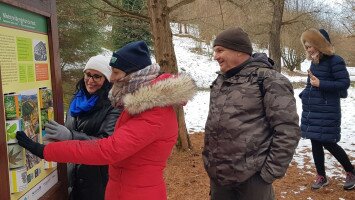
Volcano Day report 06/09/2019 6:17 PM
Aggie Reiter from the Rolling In Budapest blog gave a nice report about our Volcano Day. Here it is:
Volcano Day – Ipolytarnóc – Hungary - 06/01/2019
The ITM and Bükk National Park Directorate organised a joint press conference an Open Day of European Union Development in presenting the day connected to the Volcano Day. Within this week colorful programs offering for local and foreigner visitors to the unique Europe’s GeoPark. developments.
The invitation was to herald news about the developments by the Bükki National Park Directory jointly with the State Secretary for European Union Development. Within the presentation was told by Director of Bükk National Park that this is the first mountainous National Park of Hungary that was open on the January, 1. 1977, and lays on 38.774.6 hectares protected area. It is the third national park in Hungary. The Bükk mountain is the most extended member of the Northen Medium mountains, having the biggest average height situated. The majority of the mountain rocks consists of marine sediments which were formesome 310-330 million years ago from the 2nd part of the carbon period … but coming back to the to-day’s event continued saying the following Q.: “So although the highest peaks of Bükk do not reach the thousand meters, more than 13 billion HUF worth of development has been implemented by the Bükk National Park Directorate during the last two European cycles of Europe. The developments partly served to preserve nature conservation and partly to promote cultural value and ecotourism development and last but not least is to protect the characterictics and diverse image of the Bükk Mountains and its natural values and favorable natural properties.” The Ministerial Commissioner emphasized the government will spend about 40 billion HUF in the 2014-2020 period within the development of the National Park Directorates in the Széchenyi 2020 program. The event promotes the developments that contribute to the preservation and promotion of the natural values of Hungary said on Saturday.
Upon arrival to the venue visitors will realize ancient world tracking back in time of our old continent, whereas the attention was focused on volcanoes. By-the-way Ipolytarnóc’s is considered as the “Ancient World Pompeii”. The visitors can find themselves at the volcanic eruption preserved by the footprints of the animals, shark teeth, petrified trees at that time. The whole area holds remnants of Nature Conservation. It is a breathtaking venue of the world-famous Prehistoric Site. Just 140 kms. from Budapest which shows one of the most complex and spectacularly built-up remains of our continent. The world-renowned nature reserve declared in 1944 is the pearl of our geological heritage, an unparalleled site of ancient worlds destroyed by a volcanic catastrophe 20 million years ago.
Traveling back to 23 million years ago, twirling in the time spiral and arriving to the waters once upon a time called the Pannonian Sea. The Pannonian Sea was Miocene-Pliocene formed in an extensional basin system behind the compressional arc of the Carpathians. Its size and depth were comparable to those of the Caspian Sea. Subsidence began in Middle Miocene times, forming deep, pelagic basins, separated by reef-bearing ridges. Clastic influx filled the marginal basins during Middle Miocene time. The time tracking continued on the second leap by hopping over to the 17 million years ago at Ipolytarnóc, where at that time being baby-beasts were rushing along the river while bloody predators lurked on them.
A volcanic catastrophe destroyed the environment of ancient Ipolytarnóc 20 million years ago. The grey volcanic rock, rhyolite tuff, which demolished the paleohabitat, appears on the surface on both sides of the geological trail towards the Great Hall. It contains the charred remnants of the ancient vegetation as well.
Time travel also assisted by 3D projection on a 4D cinema or by rolling on the paths together on geological trail, while in the Miocene forest, can meet the original animals that once lived in this area – eg. can admire some of the 7 million-year-old marsh cypresses found at the entrance area of Bükkábrány.
Within a brief note … sharing some interesting facts … Some 23 million years ago the place of then present day Mediterranean was occupied by the western part of the Tethys Ocean. It had a bay that time called Paratethys shallow Sea, that ruled the area of “Ipolytarnóc. The sediment once the ooze at the bottom of the shallow sea became sandstone.The rhino footprints are the most abundant at Ipolytarnóc … 45% At the Great Hall 1298 examples of 676 specimens belong to the extinct rhinoceros. The annual rings of the old tree can be clearly seen on the polished surfaces. The rings show a thickening every 6-7 yrs. caused by the sunspot activity of that period.Tropical and subtropical rainforest dominated the landscape 20 million year ago. The annual average temp. of the region was cca. 20-25C with precipitation of 1000-3800mm/year.
Its a place where the remains of our Globe are found, will rest till the end of time.
Walking around the venue and buildings of the excavations can take a look at the world as it was known 20 million years ago and feel the atmosphere that has changed nothing since then. The duration of the tour is approx. 60-80 minutes. Guided tours in English are subject to prior arrangement.
So by visiting this precious heritage sight, leave your troubles … if any… behind, take a deep breath and cross the gate back in time to a place where paths are unwritten but the venue speaks for its own!
The design and development of touristic venue was supported by the European Union, co-financed by the European Regional Development Fund.
















